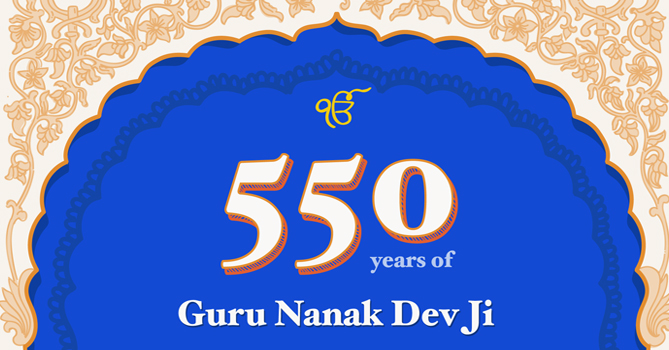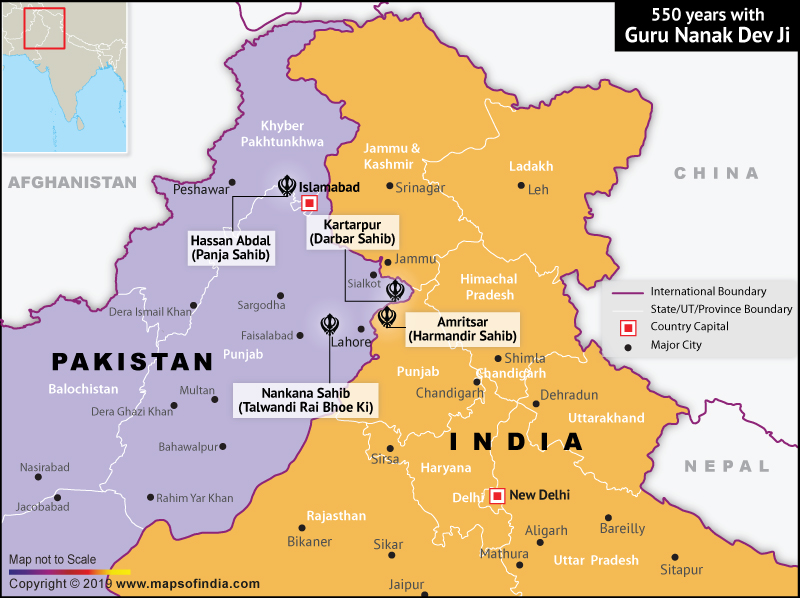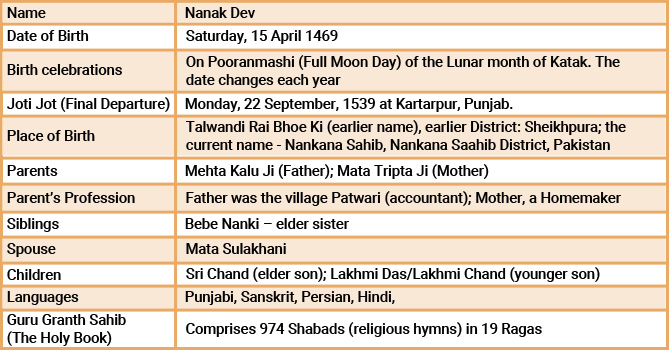

November 12, 2019, is an auspicious day for all followers of the Sikh faith.
This day marks the completion of 550 years of the birth of the founder of the Sikh faith, Guru Nanak Dev Ji. Traditionally, Guru Nanak’s birth-date is marked as the “Full Moon day/Poornamashi” of Katak/Kartik month of Lunar Calendar. For the year 2019, this date is 12 November.
Millions of followers of Sikhism and those inspired by his teachings, Sikhs, and non-Sikhs are gearing up to commemorate the special occasion grandly in different parts of the world.
What makes the event so special is the agreement reached between the Governments of Pakistan and India, allowing daily access to Sikh pilgrims to visit and offer prayers at the Darbar Sahib Gurudwara in Kartarpur, which lies on the right bank of the Ravi River and is part of Narowal district in Pakistan.
New access from the Indian border to Darbar Sahib Gurudwara called the Kartarpur Corridor would be inaugurated on 9 November 2019. Several dignitaries are expected to visit the inauguration ceremony, and the event will be broadcast “Live” across the world.
Gurupurab celebrations marking Guru Nanak’s birthday will be celebrated at Nankana Sahib, as every year, on 12 November.
To mark the occasion, Air India, India’s national airline, has decided to paint the Sikh religious symbol of “Ik Onkar” on the tail of its plane flying passengers between London and Amritsar.
We, at Maps of India, shall publish a series of articles on Guru Nanak Dev Ji, covering aspects of his life, his teachings, his followers, his journeys, and the continuing relevance of his message even today. Watch out for more in this space.
Why is Nankana Sahib so special to the Sikhs?
Nankana Sahib, city and capital of Nankana Saahib district in Pakistan, is the birthplace of Guru Nanak.
There are two schools of thought on the exact date of Guru Nanak. One records the First day of the Baisakh (Vaisakhi) month 15 April 1469, while the other records it as the Full Moon Day of the month of Katak/Kartik.
In 2019, the latter date falls on 12 November, therefore, the grand celebrations marking the 550 years of Guru Nanak’s arrival.
Guru Nanak was born to Mehta Kalu Ji and Mata Tripta Ji of village Talwandi Rai Bhoe Ki, in undivided Punjab. The village subsequently came to be known as Nankana Sahib, in honour of the founding Guru of the Sikh faith.
Located 91 km (57 miles) west of Lahore and 75 km (47 miles) east of Faisalabad in Pakistan, Nankana Sahib receives Sikh pilgrims from all over the world. In 2005, the Sheikhpura district of Pakistan, which housed Nankana town, was bifurcated, and the Nankana Sahib town became part of the newly formed Nankana Saahib district.
Radcliff’s folly
In 1947, Cyril Radcliff, a British lawyer, totally unfamiliar with India, its culture, religious diversity, and people, was tasked by the British government to divide India and create two nations; India and Pakistan, all in five weeks.
Radcliff was miserably unaware of the significance and importance of Nankana Sahib to the Sikhs, most of whom were residents of Punjab province. As a result, the border he drew left Nankana Sahib along with other revered places of worship like Panja Sahib and Kartarpur Sahib, among several others, in Pakistan.
It was a tragic decision for the Sikhs in India and other parts of the world.
What is the difference between Nankana Sahib and Kartarpur Sahib?
Nankana Sahib is where Guru Nanak was born (1469), and Kartarpur Sahib is where he spent the last years of his life. Joti Jot (Final Departure) – 1539.
Kartarpur Sahib lies on the Right bank of the Ravi River and is now part of the Narowal district in Pakistan. After 20 years of traveling and spreading his message to different parts of the world, Guru Nanak settled here with his family.
Post his passing away in 1539, both the Hindu and Muslim communities staked claim Guru Nanak’s legacy and built mausoleums here, next to each other. As the Ravi River changed course, flooding washed away the mausoleums, and so, Guru Nanak’s elder son, Baba Sri Chand, retrieved the Urn containing Guru’s ashes and reburied it on the Left bank of the Ravi River.
The town of Dera Baba Nanak, on the Indian side, grew around this site and is part of the Gurdaspur district in Punjab.
Guru Nanak Dev Ji personal snapshot:

Was Guru Nanak a saint or god?
Guru Nanak grew up a normal child but was profoundly aware and contemplative of the world around him. Over the years, as his unique message and teachings spread, people came to recognize his divine existence and accepted him as a saint and founder of the Sikh faith.
Guru Nanak – the analytical mind
Growing up in turbulent times and in a region that always bore the brunt of invaders that brought violence and terror, life was not easy on Nanak Dev. A sensitive boy, he grew up questioning the existing social and religious order, practices, and beliefs. He searched for rational answers to life.
He questioned the caste-based Hindu society around him and rebelled against the deeply ritual-based idol worship. He also disagreed with the conservative theocratic practices of the Muslim rulers while searching for an independent path to life.
His thoughts revolved around a world free of religious bigotry and ritualistic practices. He rejected the two dominant religions of his time – Hinduism and Islam.
He believed in the existence of a single Supreme power – Ik Onkar and began expressing his thoughts through Shabads or religious hymns.
He wrote 974 Shabads that form the core of the Sikh Holy Scripture – Guru Granth Sahib. The first prayer in Guru Granth Sahib, Japji Sahib, is authored by Guru Nanak. The hymns called Shabad Kirtan are sung in Gurudwara around the world and on special occasions.
Guru Nanak’s early life
At a young age, Guru Nanak showed an affinity to learn various scripts and scriptures. He learned Persian and was exposed to tenets of Islam while studying in a Madrasa. At the age of 16, he had learned Sanskrit and Hindi and read several religious scriptures, including Hindu and Buddhist scriptures.
In later years, Guru Nanak’s affinity for languages would help him in his travels to distant lands north, south, east, and west of his home (Refer to our articles on “Guru Nanak and his Travels”).
His exposure and insights into various religions and practices gave him the foundational base for his thoughts to evolve.
Guru Nanak’s first two disciples
Bhai Mardana and Bhai Bala were the first two disciples of Guru Nanak, who spent their lives with the Guru and helped spread his teachings.
His childhood friend and companion was a Muslim called Mardana, later referred to as Bhai Mardana. Bhai Mardana is recognised as the first Sikh and disciple of Guru Nanak. He used to play the musical instrument called the Rebab while Nanak Dev sang his Shabads. Together they would travel places singing hymns. Their friendship grew as their message spread.
The second principal disciple of Guru Nanak was Bhai Bala. It is through his narration in Janamsakhi Guru Nanak Dev Ji we get a glimpse into the life and teachings of Guru Nanak.
What is Guru Nanak’s Core message?
Guru Nanak believed in a universal brotherhood based on principles and values of faith, loyalty, morality, and community service. He established the “Three Pillars” that would serve as guidelines for his followers:
- Kirat Karni: Do honest work
- Vand Chakna: Share what you earn
- Naam Japo: Pray to HIS name
(For more on this, refer to our article: The Guru and His Teachings)
What is Ik Onkar or Ek Onkar?
Ik or Ek means “One,” and Onkar refers to “God.” Guru Nanak espoused the concept of Ik Onkar or the existence of one god and said all are equal before the Supreme Power and all have direct access to HIM, without the need for a priest or rituals.
The first symbol and letter in Guru Granth Sahib begin with – Ik Onkar. It is the holy symbol of the Sikh faith. [insert Symbol here].
550 years on, Guru Nanak and his teachings remain relevant in contemporary times, where the world remains polarised along religious, communal, social, and political lines.
The Sikh community in India and across the world is recognised as the First Responders in humanitarian support on all occasions and is welcomed by all local communities wherever the Sikhs live.
Our next article will cover “The Guru and the Sikhs.”





